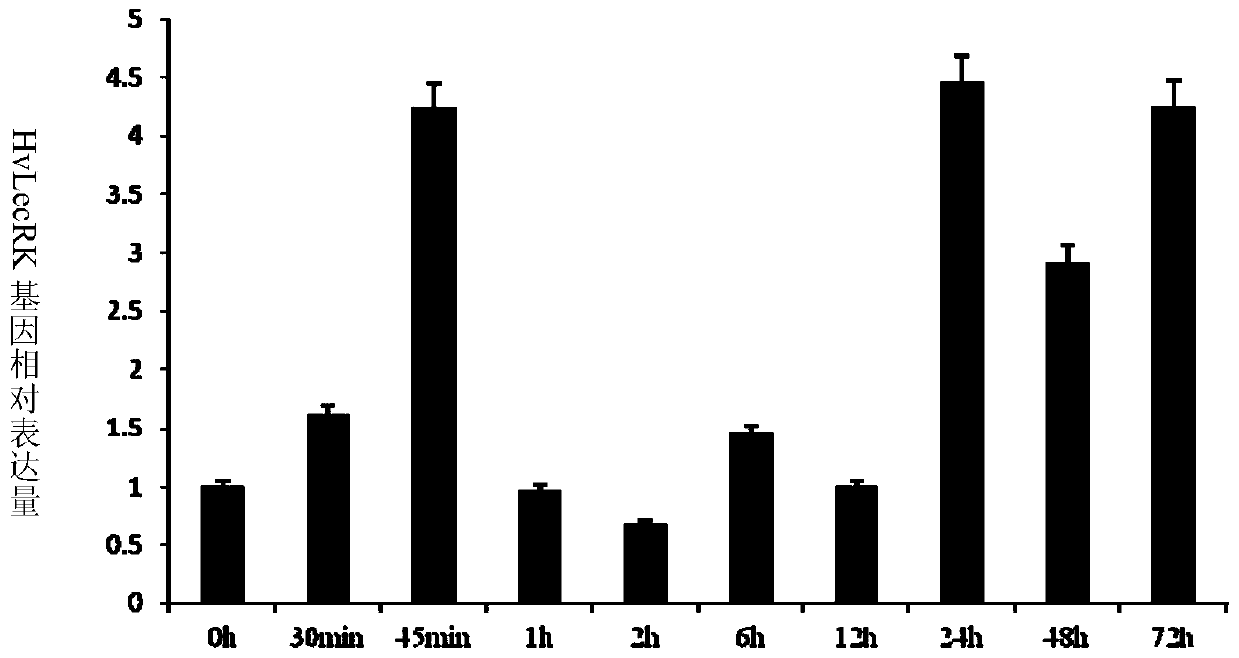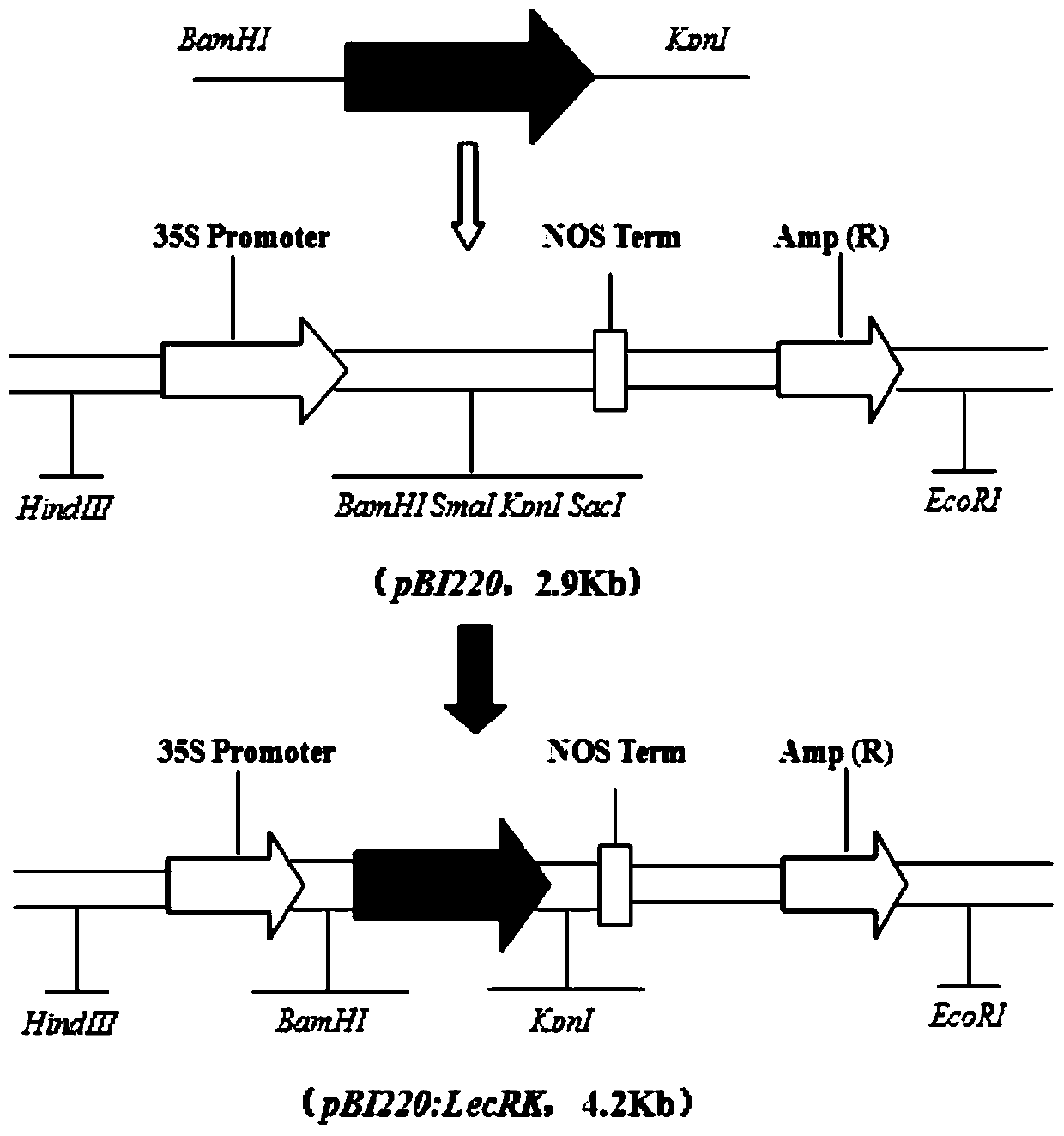A tufted wheat lectin receptor kinase gene and its expression vector and application
A kind of receptor kinase, expression vector technology, applied in the field of genetic engineering, can solve the problems of increasing manpower, material resources, environmental pollution and so on
- Summary
- Abstract
- Description
- Claims
- Application Information
AI Technical Summary
Problems solved by technology
Method used
Image
Examples
Embodiment 1
[0026] Implementation Example 1 Cloning of Hv-LecRK gene
[0027] In the previous research of our laboratory, it was found that Hv-CMPG gene plays an important role in wheat powdery mildew resistance. In order to better study the mechanism of Hv-CMPG gene resistance to powdery mildew, the yeast two-hybrid technique was used with Hv-CMPG gene as bait , Screening yeast two-hybrid library to obtain Hv-LecRK gene. Design primers P1: ATGGCCTTGGTCGTGTGCCCC (SEQ ID NO. 3) and P2: TCATCTTCCACCTGAG ATGTA (SEQ ID NO. 4), and clone the Hv-LecRK gene to obtain Hv-LecRK by using the 24h cDNA of P. tufts after being induced by powdery mildew as a template. The full length of the gene, the sequence is SEQ ID NO.1 ( figure 1 ).
Embodiment 2
[0028] Example 2 Expression characteristics of Hv-LecRK gene induced by powdery mildew
[0029] The high resistance to powdery mildew wheat line 91C43 (number: PI368886, cited from the British Botanic Garden) (reference: Qi Lili, Chen Peidu, etc., a new source of resistance to wheat powdery mildew-gene Pm21, Acta Agronomica Sinica, 1995, 21(3) ):257-262) sown in a petri dish to germinate, and then transplant it to a pot (the surrounding is isolated with a cylindrical transparent plastic sheet, and the top is sealed with a filter paper to form a powdery mildew-free environment). At the three-leaf stage, the fresh spores of Nanjing local mixed powdery mildew cultured on the susceptible variety Sumai No. 3 were gently shaken off the seedlings of P. tutus. After inoculation with powdery mildew, the leaves of Triticum aestivum were stored at 16℃. Samples were taken at 0h, 30min, 45min, 1h, 2h, 6h, 12h, 24h, 48h, 72h after inoculation, and stored in a refrigerator at -70℃ for later us...
Embodiment 3
[0031] Example 3 Construction of Hv-LecRK sense expression vector
[0032] Using the above-mentioned powdery mildew-induced Triticum aureus cDNA as a template, primer pairs P3 (CGGGATCCATGGCCTTGGTCGTGTGCC (SEQ ID NO. 5)) and P4 (GGGGTACCTCATCTTCCACCTGAGATG (SEQ ID NO. 6) that can amplify the protein coding region of the Hv-LecRK gene )) Perform PCR amplification and recover the amplified fragments. The amplified target fragment was inserted into the vector pBI220 (Jefferson RA, Kavanagh TA, BevanMW. GUS fusions: beta-glucuronidase as a sensitive and versatile gene fusionmarker in higher plants. EMBO J. 1987, 6: 3901) by double digestion with BamHI and KpnI. -3907) the multiple cloning site behind the 35S promoter between BamHI and KpnI. Thus, the target gene Hv-LecRK was cloned to the downstream of the strong promoter 35S, and the expression vector pBI220:LecRK ( image 3 ).
PUM
 Login to View More
Login to View More Abstract
Description
Claims
Application Information
 Login to View More
Login to View More - R&D
- Intellectual Property
- Life Sciences
- Materials
- Tech Scout
- Unparalleled Data Quality
- Higher Quality Content
- 60% Fewer Hallucinations
Browse by: Latest US Patents, China's latest patents, Technical Efficacy Thesaurus, Application Domain, Technology Topic, Popular Technical Reports.
© 2025 PatSnap. All rights reserved.Legal|Privacy policy|Modern Slavery Act Transparency Statement|Sitemap|About US| Contact US: help@patsnap.com



